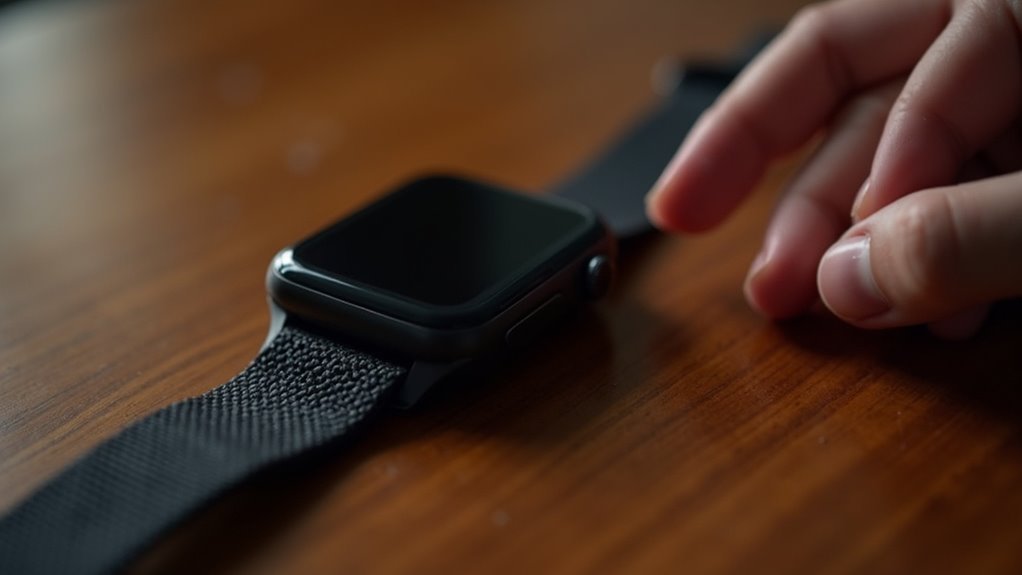You’ll master mountain elevation tracking by choosing wearable devices with sensitive barometric sensors that provide real-time readings within 3-20 foot increments. Look for GPS cross-verification capabilities, easy recalibration options, and durable waterproof designs with long battery life. Calibrate your device every 7-14 days using known elevation points, and leverage integrated weather monitoring to predict dangerous conditions. Premium options like Garmin Fenix offer superior accuracy, while budget-friendly Coros Pace 3 provides essential functionality—discover which features match your specific mountaineering needs.
Understanding Barometric Vs Gps-Based Altitude Measurement

When you’re traversing mountain terrain with wearable tech, understanding how your device measures altitude can mean the difference between accurate navigation and dangerous miscalculation.
Your wearable likely uses two distinct methods: barometric and GPS-based measurement.
Barometric altimeters calculate elevation by measuring atmospheric pressure, which decreases as you climb higher. They respond instantly to altitude changes, making them excellent for tracking your ascent or descent.
Barometric sensors track altitude changes instantly by detecting decreasing atmospheric pressure as elevation increases during your climb.
However, they require calibration with local pressure or known reference points since weather conditions affect readings.
GPS altitude works differently, using satellite signals to triangulate your position relative to Earth’s surface. GPS requires signals from a minimum of three satellites for 2D location and four satellites for 3D positioning with altitude data.
While GPS provides superior absolute accuracy over large scales, it can struggle on steep terrain due to signal obstruction and satellite geometry issues.
Essential Features to Look for in Mountain Altimeter Watches
Before you invest in a mountain altimeter watch, you’ll need to identify which features truly matter for your specific climbing objectives and terrain challenges.
Prioritize a sensitive barometric sensor that provides real-time elevation readouts with 3- to 20-foot increments for precise tracking. You’ll want GPS cross-verification capabilities to guarantee reliable readings when barometric pressure fluctuates. Look for easy recalibration options and customizable reference points to maintain accuracy during multi-day expeditions.
Essential durability features include waterproof design, shock-resistant casing, and multi-year battery life with field-replaceable options. An integrated 16-point compass, atmospheric pressure monitoring for weather forecasting, and storm alerts will enhance your navigation safety.
Consider models with heart rate monitors and wireless connectivity for thorough fitness tracking and emergency communication capabilities. Select watches that sync with popular training apps like Strava to track your climb rate, distance, speed, and elevation gain for comprehensive performance analysis.
Top Wearable Brands for Elevation Tracking Performance
Suunto stands out with devices like the Core, featuring barometric altimeters that provide accurate elevation data with proper calibration.
Apple offers versatile GPS smartwatches suitable for various mountain activities, while Wahoo produces reliable GPS watches favored by trail runners for precise elevation tracking.
Garmin dominates the hiking watch market with models like the Instinct 3 Solar and fenix 8, offering extended battery life that can last up to 40-84 hours in GPS mode for multi-day mountain expeditions.
Each brand uses different algorithms, so you’ll notice data variations between devices during identical climbs.
Calibration Techniques for Maximum Accuracy
Although various wearable devices excel at elevation tracking, you’ll achieve the most precise results by understanding proper calibration techniques.
Start by combining GPS data with digital elevation models (DEMs) to enhance accuracy. You’ll need to manually input known elevation points, especially when using barometric altimeters that measure atmospheric pressure changes.
Calibrate your device every 7-14 days for peak performance. In remote areas with poor GPS coverage, manual calibration becomes essential. Use built-in calibration tools or manufacturer-recommended apps to maintain precision.
Weather conditions affect sensor accuracy, so recalibrate frequently during changing environments. Consider using continuous calibration options that automatically adjust readings throughout your activity to address ongoing pressure changes.
Machine learning techniques like Gaussian process regression can predict calibration deterioration, helping you stay ahead of accuracy issues and ensuring consistent elevation tracking during mountain activities.
Real-Time Weather and Environmental Monitoring Capabilities

Once you’ve calibrated your wearable device for accurate elevation readings, you’ll want to maximize its real-time weather and environmental monitoring capabilities.
Your device’s environmental sensors continuously track altitude, temperature, and weather patterns, giving you vital data for mountain conditions. Storm alerts become lifesavers in mountainous terrain, while barometric altimeters predict weather changes by measuring atmospheric pressure shifts.
Environmental sensors deliver critical altitude, temperature, and weather data that can mean the difference between safety and danger in mountain terrain.
Temperature gauges help you prepare for rapid climate variations at different elevations. Multi-sport GPS smartwatches often include comprehensive environmental monitoring features like altimeters, barometers, compasses, and temperature gauges for complete mountain tracking.
Through smartphone integration, you’ll receive weather alerts directly on your wrist without fumbling for your phone. Advanced devices use downscaled satellite data and predictive analytics to forecast conditions specific to your location.
This real-time environmental monitoring transforms your wearable into an essential safety tool for mountain adventures.
Navigation and Route Tracking in High-Altitude Terrain
When you’re steering through treacherous high-altitude terrain, real-time GPS navigation becomes your digital lifeline, providing instant location data and detailed mapping that can mean the difference between reaching your destination safely or getting dangerously lost.
Advanced route planning capabilities in modern wearable devices let you chart your course before you even step foot on the mountain, allowing you to identify potential hazards, mark waypoints, and create backup routes. The track-back feature provides an additional safety net when navigating rugged mountain terrain, ensuring you can always retrace your steps to safety.
These technologies transform how you approach mountain adventures, shifting from risky guesswork to confident, data-driven exploration.
Real-Time GPS Navigation
Navigation precision becomes critical when you’re traversing high-altitude terrain where a wrong turn can mean the difference between reaching your destination safely and finding yourself stranded on an exposed ridge. Real-time GPS navigation provides continuous position updates, but you’ll face unique challenges in mountainous environments.
| Challenge | Impact |
|---|---|
| Multipath Propagation | Signal reflection off terrain causes inaccurate positioning |
| Limited Satellite Visibility | Steep slopes block signals, reducing accuracy |
| Signal Interference | Valleys and ridges disrupt GPS reception |
| Smartphone Limitations | No mobile coverage means no correction data |
You’ll get better results with frequent data collection and devices that integrate barometric sensors. While GPS elevation typically offers accuracy within +/-400 feet with strong signal reception, understanding that GPS readings can vary significantly from marked elevations on established trails and roads helps you make informed navigation decisions. More expensive GPS units typically include additional sensors that improve performance in challenging terrain, giving you the reliability you need for safe mountain navigation.
Advanced Route Planning
While real-time GPS provides your current position, successful high-altitude expeditions demand sophisticated route planning that goes far beyond basic navigation.
You’ll need thorough elevation gain assessments and trail complexity analysis to avoid dangerous overexertion on steep grades like the Great Gulf trail’s 38% incline.
Advanced planning requires these critical elements:
- Digital terrain analysis using tools like Gaia GPS and SkyVector to identify hazards and optimize routes
- Group capability assessment matching routes to your weakest member’s abilities
- Weather integration incorporating forecasts to avoid unexpected conditions
- Supply calculations ensuring adequate fuel, water, and food for extended high-altitude exposure
Establishing your current fitness levels as a baseline helps determine which routes align with your expedition team’s capabilities. Your wearable tech’s GPS and elevation tracking capabilities become invaluable for executing these sophisticated plans with precision.
Safety Benefits of Continuous Elevation Data
You’ll gain critical safety advantages when your wearable continuously tracks elevation changes during mountain adventures.
This real-time data helps you prevent altitude sickness by monitoring your ascent rate and alerting you to dangerous elevation zones before symptoms develop.
Your device also integrates weather monitoring with elevation data, giving you the insights needed to avoid hazardous conditions that become more severe at higher altitudes. The continuous monitoring capabilities allow your device to detect vital sign anomalies that may indicate early stages of altitude-related health issues.
Preventing Altitude Sickness Risks
As you ascend to higher altitudes, continuous elevation monitoring through wearable devices becomes your first line of defense against altitude sickness by tracking critical physiological changes in real-time.
These advanced tools integrate elevation data with your essential signs to provide thorough risk assessment and early warning systems.
Your wearable technology prevents altitude sickness through:
- Real-time SpO2 monitoring – Detects hypoxemia before severe AMS symptoms develop
- Predictive algorithms – AI-powered alerts analyze heart rate variability and respiratory patterns to forecast illness onset
- Ascent rate tracking – Guarantees you’re following safe climbing protocols beyond 8,000 feet
- Personalized acclimatization strategies – Trend analysis creates tailored altitude adjustment recommendations based on your individual physiological response
These capabilities transform potentially dangerous mountain adventures into safer, data-driven experiences. Military researchers have demonstrated that AMS symptoms typically peak between 18 to 24 hours after ascent, making early detection through wearable monitoring crucial for preventing serious complications.
Real-Time Weather Monitoring
Beyond preventing altitude sickness, your wearable tech transforms into an extensive weather monitoring station that continuously tracks environmental conditions and elevation changes to keep you safe in unpredictable mountain environments.
Your device’s environmental sensors detect rapid temperature changes, approaching storms, and sudden precipitation while alerting you to fog and dangerous wind conditions.
Through smartphone integration, you’ll receive immediate weather updates and customizable warnings for temperature drops or elevation changes.
The multi-sensor system combines GPS, altimeter, and weather data to create precise microclimate forecasts for your exact location. Advanced devices like the Garmin Fenix series provide detailed topographic maps with comprehensive weather overlays for superior mountain navigation.
Real-time monitoring reduces emergency response times by over 30%, while continuous elevation tracking helps rescuers pinpoint your location if needed.
Measuring and Analyzing Elevation Gain During Climbs
When you’re scaling mountain peaks, your wearable device relies on MEMS pressure sensors to track every foot of elevation gain by measuring air pressure changes and converting them into altitude data.
While GPS provides elevation accuracy to +/-400 feet with strong signals, combining these technologies with accelerometers delivers more precise readings than using individual sensors alone.
Your elevation data serves essential functions for mountain activities:
- Calorie burn calculations become more accurate when factoring in climbing intensity
- Performance tracking helps you monitor progress across different trail routes
- Workout optimization allows you to customize routines based on terrain difficulty
- Safety planning enables better route assessment and risk evaluation
Remember that environmental factors like canyons can affect accuracy, and devices from different manufacturers may show variations in readings. However, incorporating post-processing techniques with secondary information can reduce elevation measurement errors from -5% to -1%, significantly improving the reliability of your elevation gain data.
Advanced Sensor Integration for Comprehensive Monitoring
Modern mountain climbing wearables integrate multiple sensor technologies to create a thorough monitoring ecosystem that goes far beyond basic elevation tracking. You’ll find biochemical sensors analyzing your metabolic rates and sweat composition, while motion sensors track your exertion levels and fatigue. Proximity sensors alert you to nearby hazards, preventing accidents before they happen.
| Sensor Type | Primary Function | Climbing Benefit |
|---|---|---|
| Biochemical | Monitor metabolic rates | Track physical condition |
| Electrochemical | Analyze sweat composition | Assess hydration levels |
| Motion | Measure activity levels | Monitor fatigue patterns |
This extensive data analysis gives you a holistic view of your performance and condition. You’re no longer guessing about your body’s responses to altitude changes—you’re getting real-time insights that help optimize your climbing strategy and maintain safety throughout your ascent. The integration of these sensors with advanced algorithms enhances your device’s ability to provide personalized recommendations based on continuous data collection.
Cost Considerations When Choosing Altimeter Devices
When you’re shopping for an altimeter device, you’ll face a clear trade-off between budget-friendly basics and feature-rich premium models.
Basic altimeters starting around $34 provide essential elevation data, while mid-range options ($199-$359) and premium GPS watches (exceeding $800) offer advanced integration with barometers, compasses, and rugged durability. Many altimeters include elastic wrist mounts and hand mounting accessories that typically range from $35 to $50 for secure positioning during outdoor activities.
You’ll need to analyze whether the additional features justify the higher cost based on how frequently you’ll use the device and which functions truly enhance your mountain adventures.
Budget Vs Premium Features
Price differences between budget and premium altimeter devices can dramatically impact your mountain adventures, with entry-level options starting around $100 while high-end models exceed $1,000.
Budget options like the Coros Pace 3 ($229) and Suunto Core deliver essential GPS and barometric altimeter functionality with impressive battery life. You’ll get reliable elevation readings and storm alerts without breaking the bank.
However, premium devices like the Garmin Fenix offer superior accuracy and thorough multisport tracking. Solar charging capability extends battery life significantly, with models like the Garmin Fenix 7 Pro Solar lasting up to 73 hours in GPS mode using solar power.
Here’s what separates budget from premium features:
- GPS Accuracy – Premium models provide enhanced positioning precision
- Sensor Integration – Advanced devices include heart rate monitors, compasses, and thermometers
- Display Quality – High-resolution screens improve readability in harsh conditions
- Software Support – Premium brands offer regular updates and extended warranties
Value for Money Analysis
Three critical factors determine whether an altimeter device delivers genuine value for your investment: feature alignment with your specific needs, long-term reliability, and total cost of ownership.
You’ll find the sweet spot between $200-400, where devices like the Garmin Instinct Series and Suunto Core offer essential altimeter, barometer, and compass functions without unnecessary premium features.
Consider your actual usage patterns. If you’re hiking occasionally, basic altimeter functions around $35-40 suffice.
However, serious mountaineers benefit from GPS integration and solar charging despite higher upfront costs.
Battery life greatly impacts long-term value—devices requiring frequent charging or battery replacements increase ownership costs. Advanced models include storm alarm capabilities that detect sudden air pressure changes to warn users of approaching severe weather conditions.
Premium brands like Garmin and Suunto justify their pricing through superior accuracy and durability, reducing calibration frequency and replacement needs.
Performance Tracking and Athletic Analysis Tools
As you push through challenging mountain terrain, your wearable device becomes a sophisticated analytical tool that transforms raw elevation data into actionable performance insights.
These advanced systems integrate elevation tracking with biometric monitoring to provide thorough athletic analysis that’s essential for mountain sports performance optimization.
Advanced elevation tracking merges with biometric data to deliver comprehensive athletic insights crucial for optimizing mountain sports performance.
Your device’s analytical capabilities include:
- Real-time pace adjustment calculations that factor in elevation changes and terrain difficulty for accurate endurance assessment
- Heart rate correlation analysis with elevation gain to measure cardiovascular effort during climbs and optimize training intensity
- Longitudinal progress tracking for elevation-specific fitness goals like uphill running capacity and altitude acclimatization monitoring
- AI-powered pattern recognition that identifies correlations between elevation data and physiological responses for personalized training interventions
These tools enable data-driven pacing strategies and help you adjust workout intensity based on elevation-induced strain rather than simple distance metrics. Advanced mountain athletes now utilize multiple wearable devices simultaneously, with professional climbers using an average of 8 different devices weekly to capture comprehensive performance data across various physiological and environmental parameters.
Future Innovations in Wearable Elevation Technology
While current wearable elevation technology has revolutionized mountain performance tracking, the next generation of devices will integrate cutting-edge innovations that’ll transform how you navigate and analyze high-altitude environments.
You’ll soon experience AR smartglasses that overlay real-time elevation data, route guidance, and hazard warnings directly onto your field of vision. These devices will use 5G connectivity for instant data transmission, even in remote locations.
AI-powered predictive analytics will anticipate altitude sickness risks and recommend personalized acclimatization strategies based on your biometric data. Enhanced materials will make devices lighter yet more durable for extreme conditions. Generative AI will transform these wearables from simple tracking tools into comprehensive mountain safety coaches that provide tailored insights for your specific climbing conditions.
Cloud integration will enable seamless data sharing with rescue teams, while advanced biometric sensors will monitor oxygen saturation and heart rate variability specific to altitude changes, keeping you safer during challenging climbs.
Frequently Asked Questions
How Long Does the Battery Last When Using Altimeter Features Continuously?
You’ll get moderate battery drain when using altimeter features continuously. Garmin Instinct models offer up to 28 days with solar charging, while advanced watches like fenix 8 provide extended usage through efficient power management.
Can Wearable Altimeters Work Accurately in Extreme Cold Mountain Temperatures?
You’ll find wearable altimeters work accurately in extreme cold mountain temperatures. They’re designed for harsh conditions and use GPS technology that’s less affected by temperature than barometric systems, maintaining reliable altitude readings.
Do Altimeter Watches Require Cellular or Wifi Connection to Function Properly?
You don’t need cellular or wifi connections for your altimeter watch to function properly. They operate using internal barometric pressure sensors and GPS satellites, making them independent of internet connectivity for basic altitude measurements.
How Often Should I Replace My Altimeter Watch for Optimal Performance?
You should replace your altimeter watch every 3-5 years for peak performance. However, if you’re experiencing frequent calibration issues, reduced battery life, or outdated features, consider upgrading sooner.
Are Wearable Altimeters Waterproof Enough for Snow and Rain Conditions?
Most wearable altimeters with 1ATM or 50m ratings handle rain and snow well. You’ll get reliable performance in wet conditions, but they’re not suitable for deep water activities or submersion.
In Summary
You’ve now got the knowledge to choose the right wearable tech for conquering mountain elevations. Whether you’re prioritizing GPS accuracy, barometric precision, or advanced sensor integration, you’ll find devices that match your specific needs and budget. Don’t forget to master calibration techniques and leverage real-time monitoring features. As technology continues evolving, you’ll have even more powerful tools to enhance your mountain adventures and athletic performance tracking capabilities.





Leave a Reply